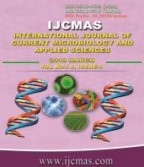


 National Academy of Agricultural Sciences (NAAS)
National Academy of Agricultural Sciences (NAAS)

|
PRINT ISSN : 2319-7692
Online ISSN : 2319-7706 Issues : 12 per year Publisher : Excellent Publishers Email : editorijcmas@gmail.com / submit@ijcmas.com Editor-in-chief: Dr.M.Prakash Index Copernicus ICV 2018: 95.39 NAAS RATING 2020: 5.38 |
The variability in water retention in soil is primarily attributable to soil texture which is mainly responsible for pore geometry and discontinuity, when compared to soil mineralogy. Under field conditions soil moisture variability is a major constraint for proper soil water management. In the present study, a pot experiment was conducted with an objective of assessing the effect of soil texture on moisture content and its depletion rate. For this purpose, the soils of seven variable textures were pre saturated and allowed to follow a drying period up to 15 days. The absolute moisture content of the soil was measured by direct gravimetric method. Besides, per cent moisture saturation and moisture depletion rate were also computed. The results showed that sandy texture (sandy, loamy sand) had low gravimetric water content (GWC) followed by a moderate GWC in loamy texture (sandy clay loam, clay loam, sandy loam). The highest GWC was recorded in clay texture (clay and sandy clay). The sandy texture exhibited a sharp drop in GWC up to a period of 7 days and thereafter attained a steady state of depletion. The results clearly indicated that fine clayey texture exhibited initially low depletion rate of 2.28 per cent GWC loss/day and could retain moisture for long period, wherein coarse sandy texture lost moisture at a faster rate with an initial depletion rate of 6.70 per cent GWC loss/day. The study concluded that there was a significant variability in moisture content and moisture retention pattern among the soils of variable texture. Hence, such in situ variability in drying pattern must be assessed prior to irrigation for efficient water management.
 |
 |
 |
 |
 |